Rugby: Difference between revisions
No edit summary |
|||
| (2 intermediate revisions by 2 users not shown) | |||
| Line 15: | Line 15: | ||
|dialling code=01788 | |dialling code=01788 | ||
}} | }} | ||
'''Rugby''' is a market town in [[Warwickshire]], standing on the [[River Avon, Warwickshire|River Avon]], 13 | '''Rugby''' is a market town in [[Warwickshire]], standing on the [[River Avon, Warwickshire|River Avon]], 13 miles east of [[Coventry]], on the eastern edge of the county, near the borders with [[Northamptonshire]] and [[Leicestershire]]. The town had a population of 61,988 in the 2001 census. | ||
The town is most famous as the birthplace of rugby football, which came from the famous public school here. | The town is most famous as the birthplace of rugby football, which came from the famous public school here. | ||
The name's likeliest origin is Old English ''Hrocan burh'' or similar | The name's likeliest origin is Old English ''Hrocan burh'' or similar, meaning "Rook's fort", where ''Rook'' may be either the bird or a man's name. Another theory is that the name is originally derived from an old British-language name ''Droche-brig'' meaning "wild hilltop". In the [[Domesday Book]] of 1086 the town is listed as ''Rocheberie''. The suffix ''-by'' is more familiar from names in northern England, coming from the Norse or Danish word for "town" or "farm" but here it is a later shortening. | ||
==Fame== | ==Fame== | ||
| Line 31: | Line 31: | ||
==The town== | ==The town== | ||
[[File:Regent Street, Rugby.jpg|thumb| | [[File:Regent Street, Rugby.jpg|thumb|250px|Regent Street with St Andrews Church]] | ||
The modern town of Rugby is an amalgamation of the original town with the villages of [[Bilton, Warwickshire|Bilton]], [[Hillmorton]], [[Brownsover]] and [[Newbold-on-Avon]] which were incorporated into Rugby in 1932 when the town became a borough;<ref>[http://www.visionofbritain.org.uk/relationships.jsp;jsessionid=E23CCC271601732AAC9B20DF4AA61813?u_id=10002485 visionofbritain.org]</ref> all except Brownsover still have their former village centres. Rugby also now includes a wider area, taking in New Bilton, Overslade and Hillside. The spread of Rugby has nearly reached the villages of [[Clifton-upon-Dunsmore]], [[Cawston, Warwickshire|Cawston]], [[Dunchurch]] and [[Long Lawford]]. | The modern town of Rugby is an amalgamation of the original town with the villages of [[Bilton, Warwickshire|Bilton]], [[Hillmorton]], [[Brownsover]] and [[Newbold-on-Avon]] which were incorporated into Rugby in 1932 when the town became a borough;<ref>[http://www.visionofbritain.org.uk/relationships.jsp;jsessionid=E23CCC271601732AAC9B20DF4AA61813?u_id=10002485 visionofbritain.org]</ref> all except Brownsover still have their former village centres. Rugby also now includes a wider area, taking in New Bilton, Overslade and Hillside. The spread of Rugby has nearly reached the villages of [[Clifton-upon-Dunsmore]], [[Cawston, Warwickshire|Cawston]], [[Dunchurch]] and [[Long Lawford]]. | ||
The town centre is mostly Victorian and early 20th century, however a few much older buildings survive, along with some more modern developments. Rugby was described by Nikolaus Pevsner as 'Butterfieldtown'<ref name="WarwickshireTownsAndVillages">Allen, Geoff, (2000) ''Warwickshire Towns & Villages'', ISBN 1 85058 642 X</ref> due to the number of buildings designed by William Butterfield in the 19th century, including much of Rugby School and the extension of St Andrew's church. | The town centre is mostly Victorian and early-20th century, however a few much older buildings survive, along with some more modern developments. Rugby was described by Nikolaus Pevsner as 'Butterfieldtown'<ref name="WarwickshireTownsAndVillages">Allen, Geoff, (2000) ''Warwickshire Towns & Villages'', ISBN 1 85058 642 X</ref> due to the number of buildings designed by William Butterfield in the 19th century, including much of Rugby School and the extension of St Andrew's church. | ||
The main shopping area in Rugby is in the streets around the Clock Tower, two of which, High Street and Sheep Street, are pedestrianised. The town centre has an indoor shopping centre called The Clock Towers which opened in 1980. A street market is held in the town centre several days a week. In recent years several out-of-town retail centres have opened to the north of the town. | The main shopping area in Rugby is in the streets around the Clock Tower, two of which, High Street and Sheep Street, are pedestrianised. The town centre has an indoor shopping centre called The Clock Towers which opened in 1980. A street market is held in the town centre several days a week. In recent years several out-of-town retail centres have opened to the north of the town. | ||
| Line 43: | Line 43: | ||
==Rugby School== | ==Rugby School== | ||
[[File:Rugby School 850.jpg|thumb| | [[File:Rugby School 850.jpg|thumb|250px|Rugby School]] | ||
The most renowned school in the town is Rugby School, founded in 1567 and the top co-educational boarding school in the country. It is one of the oldest independent schools in Britain. The | The most renowned school in the town is Rugby School, founded in 1567 and the top co-educational boarding school in the country. It is one of the oldest independent schools in Britain. The school stands in the middle of the town. | ||
The school was the birthplace of rugby football, whose rules were devised here. The famous legend is that during a match played in 1823 at Rugby School, William Webb Ellis, a pupil at the school, in defiance of the rules of football, picked up the ball an ran with it, thus creating the game. The trophy for Rugby's world championship is known as the Webb Ellis Trophy. | The school was the birthplace of rugby football, whose rules were devised here. The famous legend is that during a match played in 1823 at Rugby School, William Webb Ellis, a pupil at the school, in defiance of the rules of football, picked up the ball an ran with it, thus creating the game. The trophy for Rugby's world championship is known as the Webb Ellis Trophy. | ||
| Line 53: | Line 53: | ||
==Churches== | ==Churches== | ||
[[File:St Andrew's Church, Rugby.jpg|thumb| | [[File:St Andrew's Church, Rugby.jpg|thumb|250px|St Andrew's Church]] | ||
St Andrew's Church is the original parish church, and is a noted landmark of the town centre. A church has stood on the site since the 13th century. The church was extensively re-built and expanded in the 19th century, to the designs of William Butterfield. The expanded church included a new east tower, which has a spire 182 feet high. However some parts of the older mediæval church were retained, most notably the west tower which bears strong resemblance to a castle turret. The west tower was probably built during the reign of Henry III (1216–1272) to serve a defensive as well as religious role, and is Rugby's oldest building. The church has other artefacts of mediæval Rugby including the 13th-century parish chest, and a mediæval font.<ref name="autogenerated1">''Rugby, Aspects of the Past''. Rugby Local History Group</ref> | |||
*[[Church of England]]: | *[[Church of England]]: | ||
| Line 73: | Line 73: | ||
*United Reformed Church: Rugby United Reformed Church | *United Reformed Church: Rugby United Reformed Church | ||
*Roman Catholic: | *Roman Catholic: | ||
**St Maries[http://www.stmaries.co.uk] on Dunchurch Road. The church was built in 1872, designed by Augustus Pugin in the Early English style. | **St Maries [http://www.stmaries.co.uk] on Dunchurch Road. The church was built in 1872, designed by Augustus Pugin in the Early English style. | ||
** Sacred Heart | ** Sacred Heart | ||
==History== | ==History== | ||
Early Iron | Early Iron Age settlement existed in the Rugby area, and a few miles outside what is now Rugby, existed a Roman settlement known as ''Tripontium''. Rugby was originally a small Anglo-Saxon farming settlement, and was mentioned in the Domesday Book of 1086 as ''Rocheberie''. Rugby obtained a charter to hold a market in 1255, and soon developed into a small country market town. | ||
Rugby School was founded in 1567 by money left in the will of Lawrence Sheriff, a locally-born grocer, who moved to London and earned his fortune. Rugby School was originally intended as a school for local boys, but over time became a mostly fee-paying private school. The Lawrence Sheriff School was eventually founded in the late 19th century to carry on Sheriff's original intentions. | Rugby School was founded in 1567 by money left in the will of Lawrence Sheriff, a locally-born grocer, who moved to London and earned his fortune. Rugby School was originally intended as a school for local boys, but over time became a mostly fee-paying private school. The Lawrence Sheriff School was eventually founded in the late 19th century to carry on Sheriff's original intentions. | ||
| Line 85: | Line 85: | ||
In the 1890s and 1900s heavy engineering industries began to set up in the town, and Rugby rapidly grew into a major industrial centre. Rugby expanded rapidly in the early decades of the 20th century as workers moved into the town. By the 1940s, the population of Rugby had grown to over 40,000.<ref>[http://www.rugby-local-history.org.uk/chron.html#1900 Rugby local history group]</ref> | In the 1890s and 1900s heavy engineering industries began to set up in the town, and Rugby rapidly grew into a major industrial centre. Rugby expanded rapidly in the early decades of the 20th century as workers moved into the town. By the 1940s, the population of Rugby had grown to over 40,000.<ref>[http://www.rugby-local-history.org.uk/chron.html#1900 Rugby local history group]</ref> | ||
In the postwar years, Rugby became well served by the motorway network, with the M1 and M6 | In the postwar years, Rugby became well served by the motorway network, with the [[M1 motorway|M1]] and [[M6 motorway]]s merging close to the town. | ||
==Economy== | ==Economy== | ||
Rugby's economy is mainly industrial. It is an engineering centre and has a long history of producing gas and steam turbines at the GEC and at the AEI. The AEI was earlier British Thomson-Houston or BTH. They used to dominate employment in the town. They are now amalgamated to form Alstom. Engineering in Rugby is still the most important sector. | Rugby's economy is mainly industrial. It is an engineering centre and has a long history of producing gas and steam turbines at the GEC and at the AEI. The AEI was earlier British Thomson-Houston or BTH. They used to dominate employment in the town. They are now amalgamated to form Alstom. Engineering in Rugby is still the most important sector. | ||
[[File:Rugby cement works.jpg|thumb| | [[File:Rugby cement works.jpg|thumb|250px|Rugby Cement works]] | ||
Another major industry in Rugby is cement making; Rugby Cement works, on the western outskirts of the town, makes cement from the local Jurassic Lias limestone. The cement industry in Rugby dates back to the 1860s. In the 1990s the Rugby Cement works was dramatically expanded, and in 2000 other Rugby Cement plants at Southam and [[Rochester]] in [[Kent]] were closed, with all production moved to the Rugby plant,<ref>[http://www.mineralsuk.com/britmin/mpfcement.pdf minerals.com] (PDF)</ref> now one of the largest of its type in Europe. | Another major industry in Rugby is cement making; Rugby Cement works, on the western outskirts of the town, makes cement from the local Jurassic Lias limestone. The cement industry in Rugby dates back to the 1860s. In the 1990s the Rugby Cement works was dramatically expanded, and in 2000 other Rugby Cement plants at Southam and [[Rochester]] in [[Kent]] were closed, with all production moved to the Rugby plant,<ref>[http://www.mineralsuk.com/britmin/mpfcement.pdf minerals.com] (PDF)</ref> now one of the largest of its type in Europe. | ||
| Line 100: | Line 100: | ||
==Landmarks== | ==Landmarks== | ||
[[File:Hillmorton radio masts.jpg|thumb| | [[File:Hillmorton radio masts.jpg|thumb|250px|Rugby VLF transmitter (now demolished)]] | ||
One of the most notable landmarks around Rugby was, until August 2007, the '''Rugby VLF transmitter''', a large radio transmitting station located just to the east of the town. The station was opened in 1926 and was used to transmit the MSF time signal. Several of the masts however were decommissioned and demolished by explosives in 2004, although a few including four of the biggest masts remained until 2007. (Firing the explosive charges was delayed by rabbits gnawing the wires).<ref>{{cite web |title=Rabbits delay masts' demolition | url=http://news.bbc.co.uk/1/hi/england/coventry_warwickshire/3823335.stm | publisher=BBC News | date=20 June 2004 | accessdate=2007-09-15}}</ref> The remaining four 'tall' masts were demolished on the afternoon of 2 August 2007 with no prior publicity. | One of the most notable landmarks around Rugby was, until August 2007, the '''Rugby VLF transmitter''', a large radio transmitting station located just to the east of the town. The station was opened in 1926 and was used to transmit the MSF time signal. Several of the masts however were decommissioned and demolished by explosives in 2004, although a few including four of the biggest masts remained until 2007. (Firing the explosive charges was delayed by rabbits gnawing the wires).<ref>{{cite web |title=Rabbits delay masts' demolition | url=http://news.bbc.co.uk/1/hi/england/coventry_warwickshire/3823335.stm | publisher=BBC News | date=20 June 2004 | accessdate=2007-09-15}}</ref> The remaining four 'tall' masts were demolished on the afternoon of 2 August 2007 with no prior publicity. | ||
Rugby Cement works, to the west of the town, can be seen for many miles. Standing at 377 feet high, the landmark is not a popular one—in 2005 it came in the top ten of a poll of buildings people would like to see demolished on the Channel 4 television series ''Demolition''.<ref>{{cite web |title=The dirty dozen |url=http://www.channel4.com/life/microsites/D/demolition/worst2.html |publisher=Channel 4 |format=HTTP |accessdate=2007-09-15}}</ref> The works are also the subject of certain local controversy, as some residents believe the emissions from the works have caused health problems for local people. | |||
[[File:WWEstatue 700.jpg|thumb| | [[File:WWEstatue 700.jpg|thumb|250px|William Webb Ellis' statue]] | ||
The town has statues of three famous locals: Rupert Brooke, Thomas Hughes and William Webb Ellis. The Rupert Brooke statue is situated at the forked junction of Regent Street on the green and commemorates his contribution to poetry. Thomas Hughes' statue stands in the gardens of the Temple Reading Rooms (the central library of Rugby school) on Barby Road. Since England won the Rugby World Cup, the William Webb Ellis statue outside Rugby School is one of the most visited parts of the town. | The town has statues of three famous locals: Rupert Brooke, Thomas Hughes and William Webb Ellis. The Rupert Brooke statue is situated at the forked junction of Regent Street on the green and commemorates his contribution to poetry. Thomas Hughes' statue stands in the gardens of the Temple Reading Rooms (the central library of Rugby school) on Barby Road. Since England won the Rugby World Cup, the William Webb Ellis statue outside Rugby School is one of the most visited parts of the town. | ||
Latest revision as of 11:00, 25 January 2019
| Rugby | |
| Warwickshire | |
|---|---|
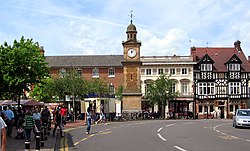 Rugby Market Place, looking west from Church Street | |
| Location | |
| Grid reference: | SP5075 |
| Location: | 52°22’12"N, 1°15’36"W |
| Data | |
| Population: | 61,988 (2001) |
| Post town: | Rugby |
| Postcode: | CV21, CV22, CV23 |
| Dialling code: | 01788 |
| Local Government | |
| Council: | Rugby |
| Parliamentary constituency: |
Rugby |
Rugby is a market town in Warwickshire, standing on the River Avon, 13 miles east of Coventry, on the eastern edge of the county, near the borders with Northamptonshire and Leicestershire. The town had a population of 61,988 in the 2001 census.
The town is most famous as the birthplace of rugby football, which came from the famous public school here.
The name's likeliest origin is Old English Hrocan burh or similar, meaning "Rook's fort", where Rook may be either the bird or a man's name. Another theory is that the name is originally derived from an old British-language name Droche-brig meaning "wild hilltop". In the Domesday Book of 1086 the town is listed as Rocheberie. The suffix -by is more familiar from names in northern England, coming from the Norse or Danish word for "town" or "farm" but here it is a later shortening.
Fame
Rugby is most famous for the invention of rugby football, which is played throughout the world. The invention of the game is credited to William Webb Ellis whilst breaking the existing rules of a football match played in 1823 at Rugby School.
Rugby School is one of England's oldest and most prestigious public schools, and was the setting of Thomas Hughes's semi-autobiographical masterpiece Tom Brown's Schooldays. A substantial part of the 2004 dramatisation of the novel, starring Stephen Fry, was filmed on location at Rugby School.
Rugby is also a birthplace of the jet engine. In April 1937 Frank Whittle built the world's first prototype jet engine at the British Thomson-Houston works in Rugby, and between 1936-41 based himself at Brownsover Hall on the outskirts of the town, where he designed and developed early prototype engines.[1] Much of his work was also carried out at nearby Lutterworth. Holography was also invented in Rugby by the Hungarian inventor Dennis Gabor in 1947.[2]
In the 19th century, Rugby became famous for its once hugely important railway junction which was the setting for Charles Dickens's story Mugby Junction.
The town
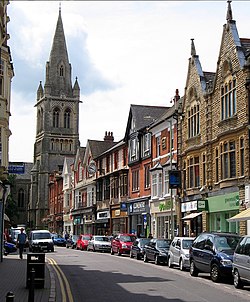
The modern town of Rugby is an amalgamation of the original town with the villages of Bilton, Hillmorton, Brownsover and Newbold-on-Avon which were incorporated into Rugby in 1932 when the town became a borough;[3] all except Brownsover still have their former village centres. Rugby also now includes a wider area, taking in New Bilton, Overslade and Hillside. The spread of Rugby has nearly reached the villages of Clifton-upon-Dunsmore, Cawston, Dunchurch and Long Lawford.
The town centre is mostly Victorian and early-20th century, however a few much older buildings survive, along with some more modern developments. Rugby was described by Nikolaus Pevsner as 'Butterfieldtown'[4] due to the number of buildings designed by William Butterfield in the 19th century, including much of Rugby School and the extension of St Andrew's church.
The main shopping area in Rugby is in the streets around the Clock Tower, two of which, High Street and Sheep Street, are pedestrianised. The town centre has an indoor shopping centre called The Clock Towers which opened in 1980. A street market is held in the town centre several days a week. In recent years several out-of-town retail centres have opened to the north of the town.
Rugby also contains several large parks, most notably Caldecott Park near the town hall. The borough council along with Warwickshire County Council currently have plans to pedestrianise North Street, a busy road through the town centre as part of the town centre's regeneration. This has proved to be very controversial, with the town's major bus operator Stagecoach in Warwickshire threatening to reduce many bus services if the road is closed to traffic.
Rugby town centre includes numerous restaurants of various kinds and many pubs. In 2002, Brownsover Fish Bar on Hollowell Way, Brownsover, was named as the best seller of Fish and Chips in the country.[5]
Rugby School
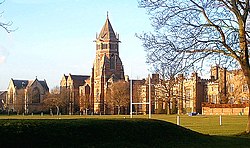
The most renowned school in the town is Rugby School, founded in 1567 and the top co-educational boarding school in the country. It is one of the oldest independent schools in Britain. The school stands in the middle of the town.
The school was the birthplace of rugby football, whose rules were devised here. The famous legend is that during a match played in 1823 at Rugby School, William Webb Ellis, a pupil at the school, in defiance of the rules of football, picked up the ball an ran with it, thus creating the game. The trophy for Rugby's world championship is known as the Webb Ellis Trophy.
Many famous people attended Rugby School, including Neville Chamberlain, Lewis Carroll, Salman Rushdie, Matthew Arnold and Thomas Hughes, the author of Tom Brown's Schooldays.
"Tom Brown's Schooldays was based on Rugby School and its famous headmaster, Thomas Arnold (who was also the father of Matthew Arnold). Arnold was the foremost promoter of "Muscular Christianity", a philosophy which has shaped the school's approach to education.
Churches
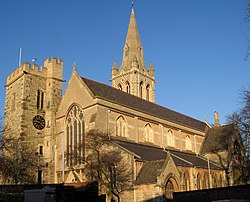
St Andrew's Church is the original parish church, and is a noted landmark of the town centre. A church has stood on the site since the 13th century. The church was extensively re-built and expanded in the 19th century, to the designs of William Butterfield. The expanded church included a new east tower, which has a spire 182 feet high. However some parts of the older mediæval church were retained, most notably the west tower which bears strong resemblance to a castle turret. The west tower was probably built during the reign of Henry III (1216–1272) to serve a defensive as well as religious role, and is Rugby's oldest building. The church has other artefacts of mediæval Rugby including the 13th-century parish chest, and a mediæval font.[6]
- Church of England:
- St Andrew's
- St Mark's, Bilton
- St George's, Hillmorton
- St Peter and St John
- St Matthew's
- St Oswald's
- Overslade Church
- Baptist:
- Independent Evangelical:
- Rugby Evangelical Free Church
- Bilton Evangelical Church
- Rugby International Fellowship Church
- Methodist: Rugby Methodist Church Centre
- United Reformed Church: Rugby United Reformed Church
- Roman Catholic:
- St Maries [1] on Dunchurch Road. The church was built in 1872, designed by Augustus Pugin in the Early English style.
- Sacred Heart
History
Early Iron Age settlement existed in the Rugby area, and a few miles outside what is now Rugby, existed a Roman settlement known as Tripontium. Rugby was originally a small Anglo-Saxon farming settlement, and was mentioned in the Domesday Book of 1086 as Rocheberie. Rugby obtained a charter to hold a market in 1255, and soon developed into a small country market town.
Rugby School was founded in 1567 by money left in the will of Lawrence Sheriff, a locally-born grocer, who moved to London and earned his fortune. Rugby School was originally intended as a school for local boys, but over time became a mostly fee-paying private school. The Lawrence Sheriff School was eventually founded in the late 19th century to carry on Sheriff's original intentions.
Rugby remained a sleepy country market town until the 19th century and the coming of the railways. In 1838 the London and Birmingham Railway was constructed around the town, and in 1840 the Midland Counties Railway made a junction with the London and Birmingham at Rugby. Rugby became an important railway junction, and the proliferation of rail yards and workshops attracted workers to the town. Rugby's population grew from just 2,500 in 1835, to over 10,000 by the 1880s.[7]
In the 1890s and 1900s heavy engineering industries began to set up in the town, and Rugby rapidly grew into a major industrial centre. Rugby expanded rapidly in the early decades of the 20th century as workers moved into the town. By the 1940s, the population of Rugby had grown to over 40,000.[8]
In the postwar years, Rugby became well served by the motorway network, with the M1 and M6 motorways merging close to the town.
Economy
Rugby's economy is mainly industrial. It is an engineering centre and has a long history of producing gas and steam turbines at the GEC and at the AEI. The AEI was earlier British Thomson-Houston or BTH. They used to dominate employment in the town. They are now amalgamated to form Alstom. Engineering in Rugby is still the most important sector.
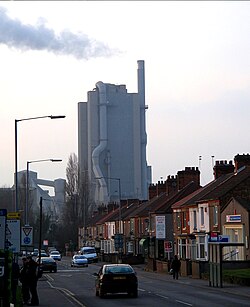
Another major industry in Rugby is cement making; Rugby Cement works, on the western outskirts of the town, makes cement from the local Jurassic Lias limestone. The cement industry in Rugby dates back to the 1860s. In the 1990s the Rugby Cement works was dramatically expanded, and in 2000 other Rugby Cement plants at Southam and Rochester in Kent were closed, with all production moved to the Rugby plant,[9] now one of the largest of its type in Europe.
Since the 1980s several large industrial estates have been built to the north of the town, and warehousing and distribution have become major employers.
Tourism is also important to the town's economy, especially related to Rugby football.[10]
A link to Rugby's rural past can still be found in the cattle market held near the railway station. A cattle market has been held in Rugby since mediæval times. From late 2008 to 2009 the cattle market are was closed down. In late October 2009, work began on the cattle market to provide a new housing estate and several shops.
Landmarks
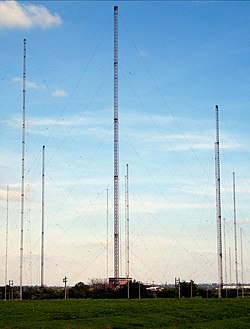
One of the most notable landmarks around Rugby was, until August 2007, the Rugby VLF transmitter, a large radio transmitting station located just to the east of the town. The station was opened in 1926 and was used to transmit the MSF time signal. Several of the masts however were decommissioned and demolished by explosives in 2004, although a few including four of the biggest masts remained until 2007. (Firing the explosive charges was delayed by rabbits gnawing the wires).[11] The remaining four 'tall' masts were demolished on the afternoon of 2 August 2007 with no prior publicity.
Rugby Cement works, to the west of the town, can be seen for many miles. Standing at 377 feet high, the landmark is not a popular one—in 2005 it came in the top ten of a poll of buildings people would like to see demolished on the Channel 4 television series Demolition.[12] The works are also the subject of certain local controversy, as some residents believe the emissions from the works have caused health problems for local people.
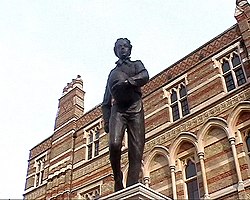
The town has statues of three famous locals: Rupert Brooke, Thomas Hughes and William Webb Ellis. The Rupert Brooke statue is situated at the forked junction of Regent Street on the green and commemorates his contribution to poetry. Thomas Hughes' statue stands in the gardens of the Temple Reading Rooms (the central library of Rugby school) on Barby Road. Since England won the Rugby World Cup, the William Webb Ellis statue outside Rugby School is one of the most visited parts of the town.
Places of interest
Places of interest in the town include:
- The Rugby School Museum, which has audio-visual displays about the history of Rugby School and of the town.
- The combined art gallery and museum. The art gallery contains a nationally-recognised collection of contemporary art. The museum contains, amongst other things, Roman artefacts dug up from the nearby Roman settlement of Tripontium.
- The Rugby Football Museum, where traditional rugby balls are hand made. It contains much rugby football memorabilia.
Places of interest around Rugby include:
- Brandon Marsh
- Coombe Abbey and Coombe Country Park
- Dunchurch - Historic village
- Draycote Water - Reservoir and nature reserve
- Oxford Canal
- Rugby School
- Stanford Hall
- Ryton Organic Gardens [2]
- Benn Hall - Conference centre and music venue
Sport
- Rugby has a number of rugby union teams including; the Rugby Lions, Rugby Welsh, Rugby St.Andrews RFC, Newbold, AEI (Rugby) Rugby Football Club and Old Laurentian RFC.
- Rugby also has a non-league football club, Rugby Town FC, (formerly known as VS Rugby) which currently plays in the Southern League Premier Division.
Rugby Welsh RFC
Rugby Welsh are a local 'junior' rugby club which were formed in 1936, and were originally known as Rugby St Andrews Welsh XV. 'The Welsh' as they are known now play in Midlands Division 4 West (South) following a league win and promotion from Midlands League 6 West (SE) in the 2008/09 season. The club still has an official club house at Bakehouse Lane, although it plays its home games at Alwyn Road, with the unofficial club house being at The Black Horse Pub in Bilton village, Rugby. Season results for Rugby Welsh RFC and further information regarding the clubs history can be found on the Rugby Welsh Website and on the RFU Website.
References
- ↑ "The Papers of Sir Frank Whittle" (HTTP). Janus. http://janus.lib.cam.ac.uk/db/node.xsp?id=EAD%2FGBR%2F0014%2FWHTL. Retrieved 2007-09-15.
- ↑ http://nobelprize.org/nobel_prizes/physics/laureates/1971/gabor-autobio.html Nobel Prize Winner Denis Garbor, inventor of holography
- ↑ visionofbritain.org
- ↑ Allen, Geoff, (2000) Warwickshire Towns & Villages, ISBN 1 85058 642 X
- ↑ Fish & Chip Shop of the Year Competition
- ↑ Rugby, Aspects of the Past. Rugby Local History Group
- ↑ Rugby local history group
- ↑ Rugby local history group
- ↑ minerals.com (PDF)
- ↑ http://www.rugby.gov.uk/site/scripts/documents_info.php?documentID=973 Rugby BC Action on Tourism
- ↑ "Rabbits delay masts' demolition". BBC News. 20 June 2004. http://news.bbc.co.uk/1/hi/england/coventry_warwickshire/3823335.stm. Retrieved 2007-09-15.
- ↑ "The dirty dozen" (HTTP). Channel 4. http://www.channel4.com/life/microsites/D/demolition/worst2.html. Retrieved 2007-09-15.
Further reading
- Rugby, Aspects of the Past. Rugby Local History Group.
- Timmins, E.W. (1990). Rugby: A Pictorial History. ISBN 0-85033-700-3.
- Elliot, Peter H (1985). Rugby's Railway Heritage. ISBN 0-907917-06-2.
- Rawlins, Eddy; Andy Osborne (1988). Rugby Growth Of A Town. ISBN 0-907917-06-2.